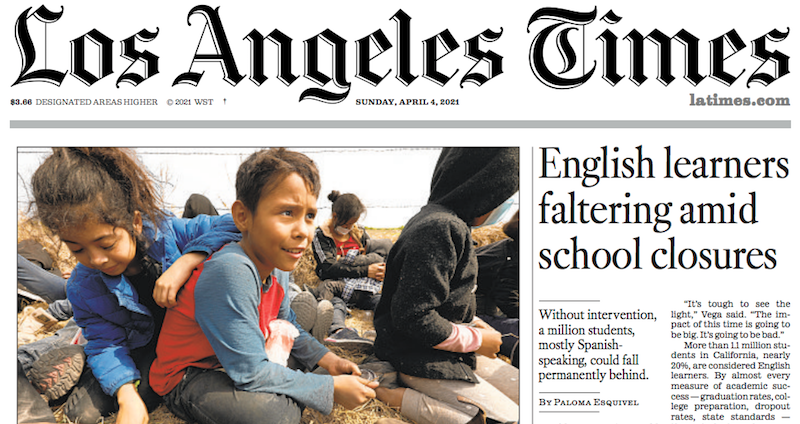The whole top half of Sunday’s Los Angeles Times featured the victimhood struggles of foreigners whom Biden and previous diversity-admiring administrations have admitted. The headline under the photo reads Migrant Kids Left Waiting for Days, a typical media sob story about illegal aliens.

More alarming in a way is how the article on the right indicates a failure of basic language learning among foreign and/or hispanic students. The piece omits certain helpful information, such as citizenship and time of residence, and instead concentrates on the problems caused by the pandemic.
But when a 13-year-old who has “attended Los Angeles schools since kindergarten” and still cannot speak English, the problem is something other than the virus.
The situations of education failure described are concerning, particularly with what’s coming in a few months — thousands of illiterate foreign children admitted via Biden’s open border will arrive and schools will have to cope. Previous diverse kid dumps have proved expensive to local school districts across the country.
Plus, another strategy of diversity enthusiasts has been to promote a bilingual America which has never been popular among citizens.
A looming catastrophe is about to strike America’s schools. Hopefully the press will report how citizen kids are directly cheated by Biden’s open border. They shouldn’t be forgotten in all the tiresome overdone media concern about foreign children.
The Los Angeles Times supplied hint of what’s coming (reprinted by Yahoo.com, below):
In California, a million English learners are at risk of intractable education loss, by Paloma Esquivel, L.A. Times, April 4, 2021
Aida Vega’s 13-year-old daughter, who has attended Los Angeles schools since kindergarten and is in eighth grade, still struggles to read and write English.
Vega has long pushed for extra help so her child can master the language. Early last year, she felt confident that a breakthrough was at hand — her daughter’s teachers had a plan to start additional tutoring in March.
Then schools closed. Tutoring was canceled, except for a short stint during the fall semester. Vega says her daughter’s schooling became a constant struggle. There are days when Vega has found her in tears next to her computer. In the fall, after teachers said her daughter was failing all of her classes, Vega began taking jobs cleaning homes and offices to pay $45 an hour for a private tutor. But she worries her daughter is still falling behind.
“It’s tough to see the light,” Vega said. “The impact of this time is going to be big. It’s going to be bad.”
More than 1.1 million students in California, nearly 20%, are considered English learners. By almost every measure of academic success — graduation rates, college preparation, dropout rates, state standards — these students rank among the lowest-achieving groups. And that was before pandemic-forced campus closures. One year later, this massive population of students is at great risk of intractable educational loss, experts said.
“It’s an educational pandemic,” said Martha Hernandez, director of Californians Together, a nonprofit that advocates for English learners. “We already had issues of an achievement gap, opportunity gaps, lack of access, lack of equity. Now that’s just exacerbated, and it will be a huge challenge. It will have a big impact for many, many years.”
She and other experts, parents and educators say schools must make immediate and swift interventions to salvage the education of English learners — 80% of whom speak Spanish — including improving distance learning for those families that choose to continue online and extending the school year and school days to allow for additional learning time.
An abundance of reports in California and throughout the country show the dire toll distance learning has taken on these students.
The Los Angeles Unified School District educates about 120,000 English learners, or 20% of its students, and reported that in spring 2020 fewer than half of English learners in middle and high school participated in distance learning each week — a gap of about 20 percentage points compared to students who are proficient in English.
Last month, the district reported that 42% of grades earned by English learners in high school were Ds and Fs, an increase of 10 percentage points from the prior year — greater than any other group except homeless youth. Middle schoolers saw a 12 percentage point increase in Ds and Fs.
And fall interim assessment results indicate that more than 94% of the district’s English learners in middle and high school were not on grade level in reading and math, according to a report this week by the advocacy group Great Public Schools Now, based on district data. (Continues)


